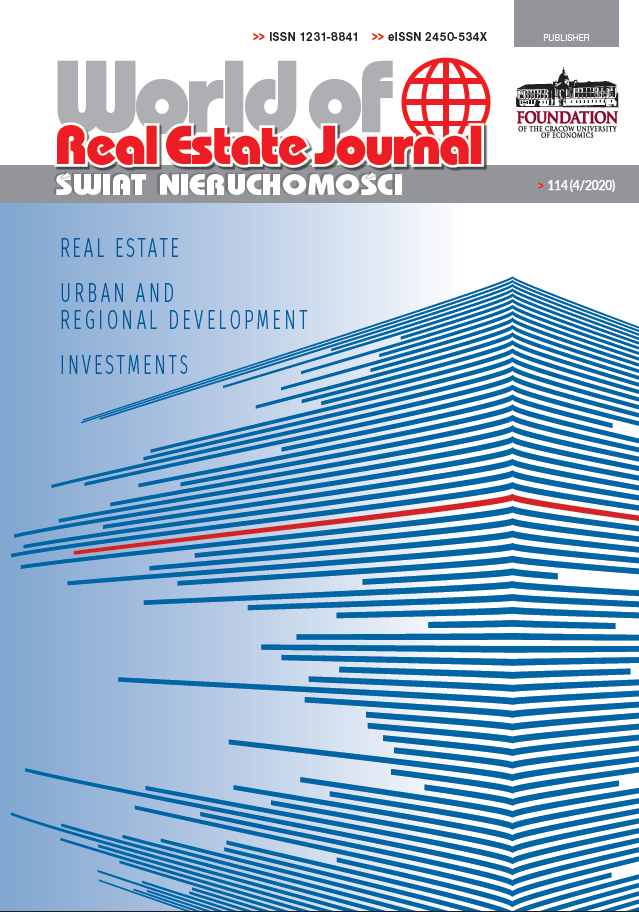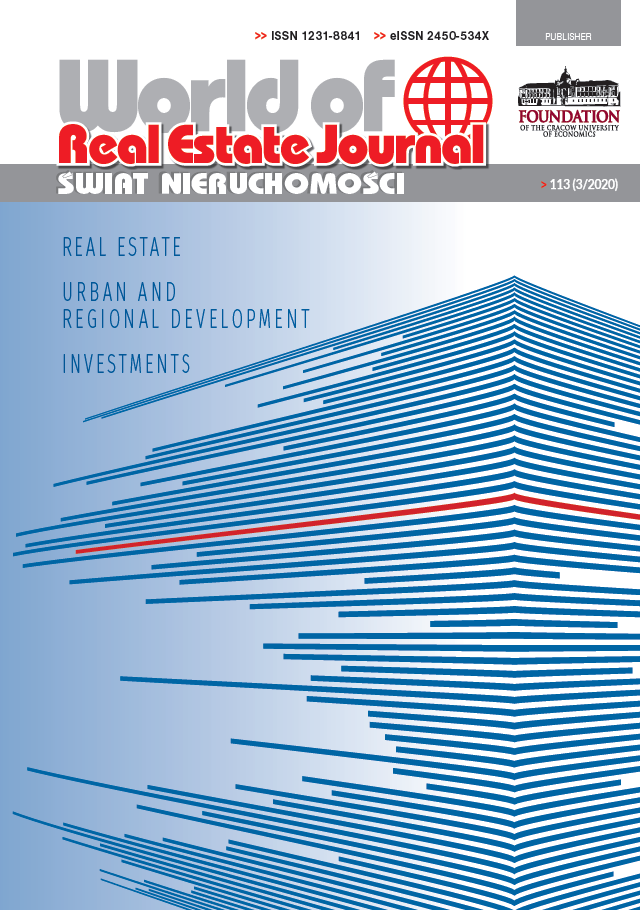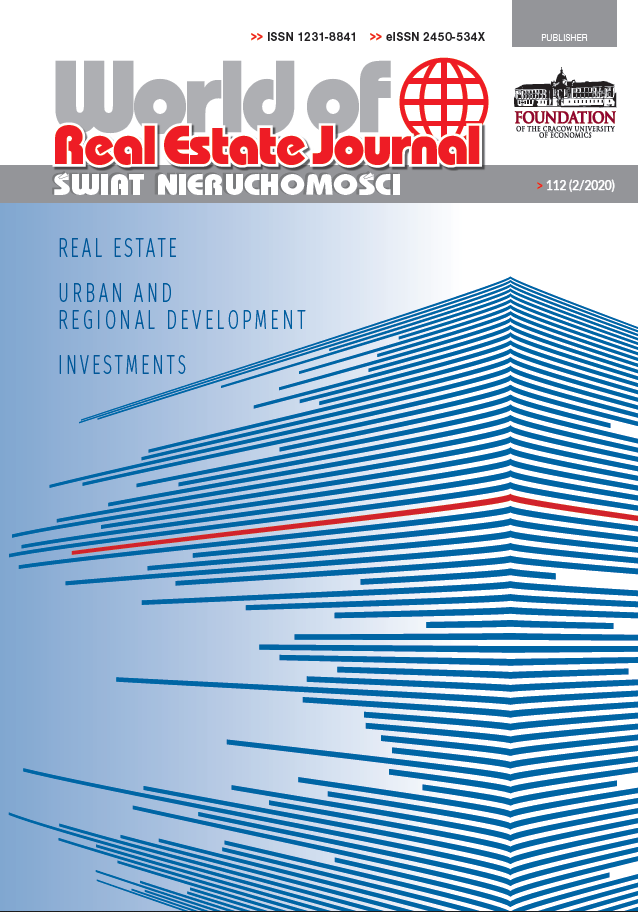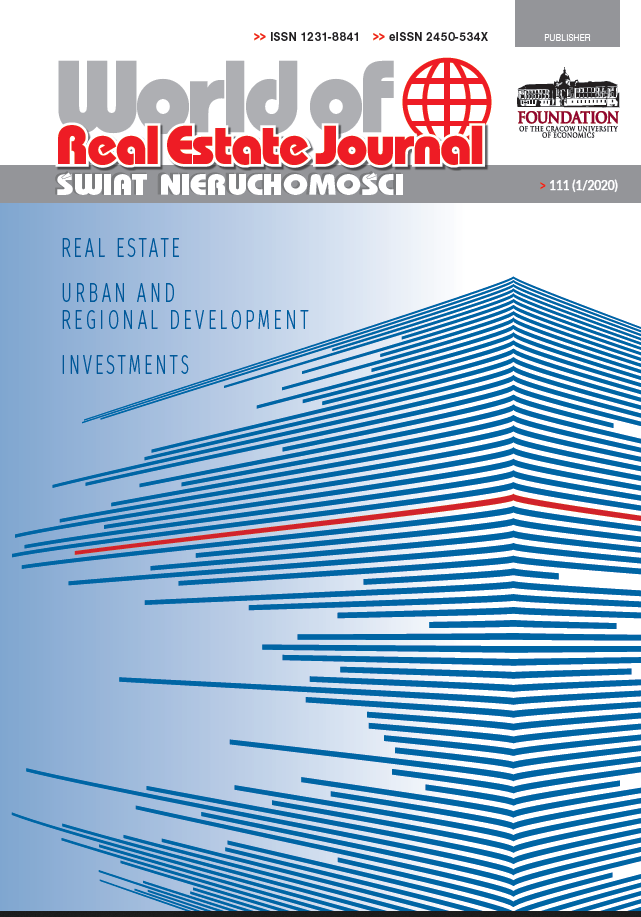MARKET
1. Michał Kruszka, Radosław Trojanek - The Synchronization of Price Cycles in the Local Housing Markets in Poland in 1996-2012
2. Stanisław Belniak, Magdalena Gołaś-Podolec - Prohibited Concractual Provisions in Developer Contracts of Cracow Housing Investments
3. Tamara Florićić - Development Potential of the Croatian Hotel Industry
4. Piotr Kwapień - The Size and the Structure of Supply of Two-room Flats in Krakow and Pricing Implications
PROBLEMS OF URBAN DEVELOPMENT
5. Anna Gospodinova - Multi-factor Ground for Urban Sprawl
INVESTMENTS
6. Bernhard Funk - German Real Estate Funds: Structural Changes in the Market Following Implementation of AIFM-Directive
7. Elżbeta Radziszewska-Zielina, Grzegorz Śladowski - Analysing Decision-making Models for Choice of Adaptation Options for Derelict Buildings
8. Andrej Adamuśćin, Marzia Morena, Tommaso Truppi - The Importance of Sustainable Construction of Office Buildings and its Development in Italy and in Visegrad countries (mainly in Slovakia)
9. Michał Juszczyk - The Use of aFaceted Classification System for Managing Cost Information in Construction Projects
FINANCES
10. Daniela Śpirkova - Impact of the Global Crisis on Changing the Financing Rules of Residential Properties in Slovakia
11. Jarosław Kaczmarek - Creating Shareholder Value in Listed Construction Companies
REAL ESTATE MANAGEMENT
12. Bartłomiej Marona - The Rationality of Real Estate Management: the Aims of Ownership in the Private and Public Sector
13. Edyta Izabela Głuszek, Małgorzata Zięba - Property Accounting in Commercial Property Management
CONFERENCES
14. Marlena Jankowska - “GIS ODYSSEY 2014”- Conference & Exhibition (Crikvenica, Croatia, 1st–5th September, 2014) DOWNLOAD
15. Andrzej Jaki - 19th International Scientific Conference “RESTRUCTURING IN THE FACE OF CHALLENGES OF THE GLOBAL ECONOMY” (Krynica-Zdrój, 22nd–25th October, 2014) DOWNLOAD
WORLD OF REAL ESTATE JOURNAL
16. Table of Contents 2014 DOWNLOAD
LIST OF REVIEWERS
17. List of Reviewers 2014 DOWNLOAD
SUMMARIES
Michał Kruszka, Radosław Trojanek - The Synchronization of Price Cycles in the Local Housing Markets in Poland in 1996-2012
The main aim of the paper was to identify the synchronization of dwelling price cycles in the secondary housing market in the years 1996-2012 in the six biggest cities in Poland. This aim determines the scope of the subject, which includes price changes in the secondary housing market, relating both to full and limited ownership rights to private accommodation. The research refers only to dwellings located in multi-family buildings.
Keywords: business cycle; housing market; house price cycle
JEL Classification: R30, D03, D70
Citation (APA): Kruszka, M.,Trojanek, R.(2014). The Synchronization of Price Cycles in the Local Housing Markets in Poland in 1996-2012. Świat Nieruchomości, (4(90)), 5-11.
DOI: 10.14659/worej.2014.90.01
READ ALL...Stanisław Belniak, Magdalena Gołaś-Podolec - Prohibited Contractual Provisions in Developer Contracts of Cracow Housing Investments
The developer contract is the instrument for the allocation of risk in the primary housing market. The need to involve considerable financial resources on the side of the developer, the uncertainty with regard to the finalization of the investment process and the transfer of ownership of the property to the buyer, are only some of several factors that determine the need for precise regulation of contractual mutual obligations of the developer and the buyer. In view of the dynamic development of residential projects in recent years, not uncommonly becomes a phenomenon of fraudulent behavior in the mutual obligations of the parties of the developer contract with regard to concluding in it’s content the so-called prohibited contractual provisions called “abusive clauses” which results in significant consequences of an economic nature. These consequences must be considered at several levels . The effects of the developer agreements are both individual and then to be considered with regard to the analysis of quantifiable losses that the buyer has suffered concluding such an agreement covering the records belonging to the catalog of unfair contractual terms, as well as general, which allows for a broader assessment of the scale of the phenomenon, and as a go - evaluation of risks associated with the purchase of residential property within the primary market and the impact of such improper practices established on the opportunities and the quality of its‘ further development. It should also be emphasized that the housing market is a key area of development activity in Poland.
Keywords: law; real estate; prohibited contractual provisions; developer housing investments; developer contract
JEL Classification: K12
Citation (APA): Belniak, S.,Gołaś-Podolec, M.(2014). Prohibited Contractual Provisions in Developer Contracts of Cracow Housing Investments.
Świat Nieruchomości, (4(90)), 13-18.
DOI: 10.14659/worej.2014.90.02
READ ALL...Tamara Floričić - Development Potential of the Croatian Hotel Industry
Croatia is a post transitional country which bases its economic development on tourism as a strategic industry which links several economic branches: from agriculture and product placement, through tourist expenditure, production and processing industries, service and commercial businesses, to the provision of tourist services in a tourist manner, in tourist accommodation facilities. Building of tourist accommodation facilities develops the construction business and affiliated businesses, thus forming a portfolio of properties which represent fixed assets in the balances of hotel and hospitality companies. The aim of this paper is to examine the total accommodation offer of the Croatian hotel industry, to review and analyse different structures’ shares and to assess the categories and competitiveness, as well as the potentials in the valorisation of property as assets which affect the valorisation of tourist companies. The purpose of the paper is reflected in the usefulness of the realisation of the goal, in the cognisance of the problem area of organisation of tourist accommodation facilities in Croatia, as well as in the recognition of the demand for change. The methodology applied in the research includes methods of analysis and synthesis, deduction, comparison and statistical methods of review of the structure and quality of tourist properties in Croatia. The research gives an insight into the current position of the Croatian hotel industry, opening possibilities for further research work.
Keywords: tourism; accommodation facilities; quality; hospitality companies
JEL Classification: L83, L85
Citation (APA): Floričić, T.(2014). Development Potential of the Croatian Hotel Industry.
Świat Nieruchomości, (4(90)), 19-25.
DOI: 10.14659/worej.2014.90.03
READ ALL...Piotr Kwapień - The Size and the Structure of the Supply of Two–Room Flats in Cracow and Pricing Implications
This article presents the results of the research concerning two–room flat supply in Cracow during the period of 2010–2013, with an analysis of their prices, also in terms of forecasting. The analyses were based on own, unique database created using 14,000 real estate advertisements in Cracow on the primary and secondary market. The volume and the structure of the supply (advertisements) were measured using statistical methods. A comparative analysis of Cracow districts was also conducted. It included the number of two–room flats for sale, the density of population, average prices and their range. A trend for a decrease in the price for a square metre of a flat was shown, as well as the difference in pricing and the price range depending on the location of the flat (district and floor). It proved the lack of statistically significant correlation of price and supply which occurred strong only at the level of average values, which describes a market failure.
Keywords: real estate market; investment decisions; comparative analysis; rynek nieruchomości; decyzje inwestycyjne; analiza porównawcza
JEL Classification: R32
Citation (APA): Kwapień, P. (2014). The Size and the Structure of the Supply of Two–Room Flats in Cracow and Pricing Implications. Świat Nieruchomości, (4(90)), 27-34.
DOI: 10.14659/worej.2014.90.04
READ ALL...Anna Gospodinova - Multi-factor Grounds for Urban Sprawl
In the scientific literature there are different opinions on the factors that lead to urban sprawl. There are no summarizing concepts about the basic reasons and factors. That is why, it is necessary to find out and study the factors which cause this process in view of preventing the negative consequences of urban sprawl – ecological, social and economic ones. The goal of this paper is to analyse, systematize and group the plentiful factors which influence urban sprawl.
Keywords: urban sprawl; suburbs; non-urbanised territories; urbanised territories
JEL Classification: R14, O180
Citation (APA): Gospodinova, A.(2014). Multi-factor Grounds for Urban Sprawl.
Świat Nieruchomości, (4(90)), 35-38.
DOI: 10.14659/worej.2014.90.05
READ ALL...Bernhard Funk - German Real Estate Funds: Structural Changes in the Market Following the Implementation of the AIFM Directive
The article looks at the structure of the German market for German real estate funds. Focus is given on the changes that have been triggered recently alongside the implementation of the European AIFM Directive. The main segments of the markets, which are open-end, closed-end and Special Funds, are considered. The evolvement of the liquidity crisis of German open-end funds, which were rooted in factors found in the previous legislation of German investment fund law before the AIFM Directive was introduced, is explored. Furthermore, the significant market changes for Germany´s closed-end market are explored. The outlook draws on competitive theory to derive the future path for the German industry for real estate funds.
Keywords: real estate funds; closed-end funds; open-end funds; Germany; AIFM Directive
JEL Classification: G23, G32
Citation (APA): Funk, B.(2014). German Real Estate Funds: Structural Changes in the Market Following the Implementation of the AIFM Directive.
Świat Nieruchomości, (4(90)), 39-44.
DOI: 10.14659/worej.2014.90.06
READ ALL...Elżbieta Radziszewska–Zielina, Grzegorz Śladowski - Analysing Decision-making Models for the Choice of Adaptation Options for Derelict Buildings
The process of extending life cycle of derelict buildings usually involves an analysis of several adaptation options against a set of criteria adopted by a decision-maker. The literature worldwide mentions several decision-making models for the choice of the methods of reusing derelict buildings. The authors of this paper selected the most representative ones, differing as to the problem solution approach, and then evaluated their possibilities and limitations, and finally proposed guidelines for the future development of a comprehensive original approach to the choice of adaptation options for a derelict building.
Keywords: adaptation of derelict buildings; multiple-criteria analysis; sustainable development
JEL Classification: C30, C60, D81, D85
Citation (APA): Radziszewska–Zielina, E., Śladowski, G.(2014). Analysing Decision-making Models for the Choice of Adaptation Options for Derelict Buildings. Świat Nieruchomości, (4(90)), 45-50.
DOI: 10.14659/worej.2014.90.07
READ ALL...Andrej Adamuščin, Marzia Morena, Tommaso Truppi - The Importance of Sustainable Construction of Office Buildings and its Development in Italy and in the Visegrad Countries (Mainly in Slovakia)
For the real estate sector, environmental sustainability is fundamental not only for matters of social responsibility and contribution to the preservation of the environment, the paper sustains, but also because it can be an element that determines the property value and investors’ attractiveness. Recent years, along with the awareness towards energy and environmental issues, have witnessed an increasing number of tools for evaluating the performance of buildings from the point of view of sustainability. The paper outlines the diffusion of sustainable construction of office buildings in the Visegrad countries /Slovakia (mainly), the Czech Republic, Poland and Hungary/ and in Italy, highlighting the necessity to focus both on energy-efficient new buildings and retrofits/refurbishment of the existing ones.
Keywords: Sustainable office building; Sustainable construction; Environmental (green) certificates; Energy efficiency; LEED; BREEAM
JEL Classification: R33, Q56, Q2, M2
Citation (APA): Adamuščin A.,Morena, M.,Truppi, T. (2014). The Importance of Sustainable Construction of Office Buildings and its Development in Italy and in the Visegrad Countries (Mainly in Slovakia). Świat Nieruchomości, (4(90)), 51-57.
DOI: 10.14659/worej.2014.90.08
READ ALL...Michał Juszczyk - The Use of a Faceted Classification System for Managing Cost Information in Construction Projects
Effective information flow and exchange are among key factors affecting the success of a construction project in terms of time, cost and quality. Due to the intensive development and application of information technologies in the field of construction management, it is essential to define processed information unambiguously. The paper presents two concepts of classification systems – enumerative systems and faceted systems. The author introduces a short review and comparison of both systems. A concise discussion of benefits that result from the application of polyhierarchical systems in the construction cost analysis and a short calculation example are presented.
Keywords: faceted classification system; construction cost management; construction management
JEL Classification: L74, M11, D24
Citation (APA): Juszczak, M. (2014). The Use of a Faceted Classification System for Managing Cost Information in Construction Projects. Świat Nieruchomości, (4(90)), 59-64.
DOI: 10.14659/worej.2014.90.09
READ ALL...Daniela Špirková - Impact of the Global Crisis on Changing the Financing Rules of Residential Properties in Slovakia
The global financial crisis has dramatically changed from the basis not only rules of the real estate market financing, but also permanently changed the banking sector in many countries. Due to the crisis, banks have become more cautious in implementing the operations and money lending and effectively began to measure and evaluate the credit risk. Increase in risk also encouraged the adoption of agreements on capital adequacy and the establishment of prudential rules in banking institutions. In this context, the National Bank of Slovakia starts considering the changes in the credit financing of residential properties because of possible risk which is related to evolution of the value of the loan and real estate. This article focuses on the current situation on the residential market in the Slovak Republic in terms of interest rates, loan financing of new residential projects, housing affordability (Housing affordability index) as well as supply and demand
Keywords: global financial crisis; residential Properties; financing rules; Slovak Republic
JEL Classification: G21, R30
Citation (APA):: Špirková, D. (2014). Impact of the Global Crisis on Changing the Financing Rules of Residential Properties in Slovakia. Świat Nieruchomości, (4(90)), 65-70.
DOI: 10.14659/worej.2014.90.10
READ ALL...Jarosław Kaczmarek - Creating Shareholder Value in Listed Construction Companies
The paper focuses on issues related to assessing corporate values creation from the perspective of a company’s owners. Attention is given to the use of external and internal assessment measures – market and economic values added. The paper presents the possibility of extending the area of the perception of these measures by introducing the concept of excess value. The paper is one of the publications in this area (as the cycle), so its theoretical and methodological dimensions are confined to basic concepts, with references being made to other works. The developed concept is a basis for conducting an empirical study of a group of listed construction companies. The obtained results based on a mid–term assessment confirm the hypothesis concerning a strong correlation between changes to excess market value added and the capitalisation of companies and the absence of correlation between these changes and economic and market value added changes.
Keywords: value creation; value added; construction secto
JEL Classification: G 32
Citation (APA): Kaczmarek, J. (2014). Creating Shareholder Value in Listed Construction Companies. Świat Nieruchomości, (4(90)), 71-76.
DOI: 10.14659/worej.2014.90.11
READ ALL...Bartłomiej Marona - The Rationality of Real Estate Management: the Aims of Ownership in the Private and Public Sector
The aim of this article is to present the problem of assessment of the rationality of property management in the context of different ownership goals. Due to a small number of research which are dealing with public sector, the main goal of this work is to present the nature of assessment of real estate management in the public sector and present indicators related to the assessment of real estate management in a commune. In conclusions it is necessary to emphasize that the assessment should have a multi-criterion character, not only a short-term but also a long-term perspective, and take into account various (financial and social) aspects of real estate management, remembering that the assets which are at the disposal of a public unit are one of the most important instruments to The discussion is based on literature review.
Keywords: real estate; real estate management; rationality; public sector; nieruchomości; zarządzanie nieruchomościami; racjonalność; sektor publiczny
JEL Classification: H19, H82
Citation (APA): Marona, B. (2014). The Rationality of Real Estate Management: the Aims of Ownership in the Private and Public Sector. Świat Nieruchomości, (4(90)), 77-82.
DOI: 10.14659/worej.2014.90.12
READ ALL...Edyta Izabela Głuszek; Małgorzata Zięba - Property Accounting in Commercial Property Management
In large and developed property markets as the UK, institutional investors do not manage their portfolios but rather outsource management operations to specialized companies. Property accounting is one the most important services as it provides important financial information on property performance to owners and users (tenants). In the UK, property accounting, in order to provide unified and transparent reports on costs and revenues is regulated by three basic standards of accounting: Royal Institute of Chartered Surveyors (RICS), Generally Accepted Accounting Principles (GAAP) and International Financial Reporting Standards (IFRS). The RICS standard defines the content, principles of reporting to owners and tenants. Capita is one of the biggest managing companies on the British property market, offering various management services to investors, including accounting, presented in the paper. These highly specialized management services are almost unknown on the Polish property market, and there is no local standardization of property accounting. With the market of institutional investments growth and development, the demand for specialized property management services will increase in Poland and the need for the application or development of the local standards of reporting will emerge
Keywords: property accounting; accounting standards; investment property; managing company
JEL Classification: R33, M41
Citation (APA): Gluszak, I., Zięba, M. (2014). Property Accounting in Commercial Property Management. Świat Nieruchomości, (4(90)), 83-89.
DOI: 10.14659/worej.2014.90.13
READ ALL...





















































